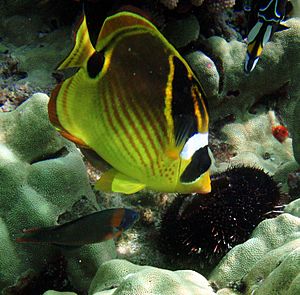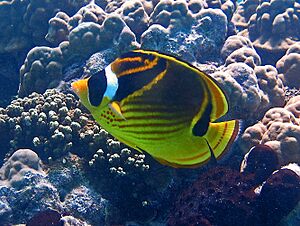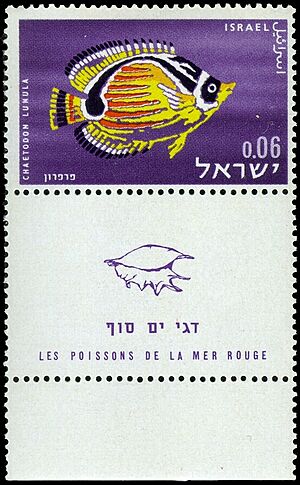Raccoon butterflyfish facts for kids
Quick facts for kids Raccoon butterflyfish |
|
|---|---|
 |
|
| Off Kona (Hawaiʻi), feeding on a sea urchin while a saddle wrasse, Thalassoma duperrey (lower left), waits for morsels | |
| Conservation status | |
| Scientific classification | |
| Genus: |
Chaetodon
|
| Species: |
lunula
|
| Synonyms | |
|
|
The raccoon butterflyfish (Chaetodon lunula) is a colorful fish that lives in the ocean. It's also known by many other names like the crescent-masked butterflyfish or moon butterflyfish. These fish are a type of ray-finned fish and belong to the butterflyfish family. You can find them swimming in the Indian and Pacific Oceans.
Contents
About Its Name
The raccoon butterflyfish was first officially described in 1802 by a French scientist named Bernard Germain de Lacépède. He gave it the scientific name Pomacentrus lunula. The fish was found in the Indian Ocean.
This fish belongs to a larger group of butterflyfish called Rabdophorus. Its closest relative is the Red Sea raccoon butterflyfish, also known as the diagonal butterflyfish (C. fasciatus). Other fish that are related include the black butterflyfish (C. flavirostris), the Philippine butterflyfish (C. adiergastos), and the redtail butterflyfish (C. collare).
Even though these related fish have different colors, they are all fairly large and have an oval shape. Most of them have stripes on their sides that go upwards. Many of them also have a dark "raccoon" mask pattern around their eyes, which is how the raccoon butterflyfish got its common name!
What They Look Like
The raccoon butterflyfish can grow up to 20 centimeters (almost 8 inches) long. They have an oval body shape. Their sides are covered with reddish stripes that go upwards.
Their face has black and white bands around their eyes, which looks a lot like a raccoon's mask. This is why they are called "raccoon butterflyfish." They also have a black spot near their tail and yellow stripes behind their head. These fish have 10 to 14 spines on their back fin and 3 spines on their belly fin.
What They Do and Eat
Raccoon butterflyfish are active at night. They usually live in small groups. Adult fish mostly eat small sea creatures like nudibranchs (sea slugs) and other tiny animals without backbones. They also eat algae (seaweed) and parts of coral polyps.
Where They Live
You can find the raccoon butterflyfish in many warm parts of the world. They live across the tropical Indo-Pacific region, from East Africa all the way to the Hawaiian and Marquesan islands. They are also found north of Japan and in the southeast Atlantic Ocean near South Africa. However, you won't find them in the Red Sea.
Their Home
These fish like to live in coral reefs. They prefer the outer parts of reefs that face the open ocean. They also live in shallow, flat areas inside lagoons. You can find them at depths of more than 30 meters (about 100 feet).
Raccoon Butterflyfish as Pets
Raccoon butterflyfish are usually friendly with other fish in an aquarium. But they might not get along well with lionfish or triggerfish. In a home aquarium, a raccoon butterflyfish can live for about five to seven years.
These fish can be helpful in aquariums because they eat certain types of sea anemones that can be a nuisance, like Aiptasia and Majano anemones. They can get rid of these unwanted anemones in a few weeks. However, they also love to eat soft corals, which are often used for decoration in tanks. So, they might cause more harm than good to your aquarium's look.
In a closed tank environment, these fish can sometimes get a sickness called "marine ich." This is caused by a tiny parasite called Cryptocaryon irritans.
See also
 In Spanish: Pez mariposa mapache para niños
In Spanish: Pez mariposa mapache para niños




